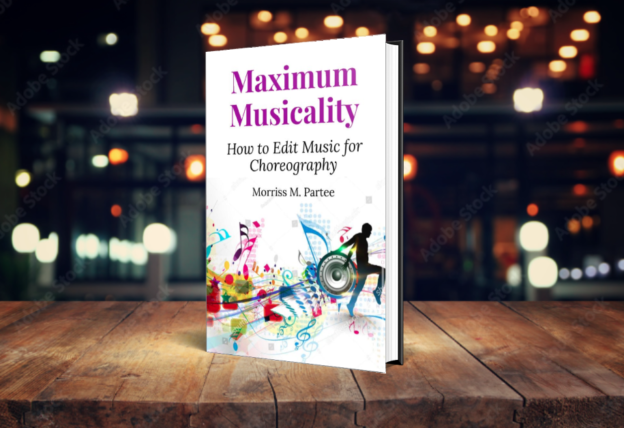
Introduction
Dance is the art of human movement. And while dance can exist without music, most dance is performed with a soundtrack. Dance is an expression of our human experience, an expression which is both visual and auditory. In dance, the importance of costume, lighting, and movement is well understood. While most dancers intuitively understand how important music is to dance, what is often underappreciated is how the emotional arc of a soundtrack can dramatically affect how an audience perceives a routine.
For more than ten years, I have had the great honor of creating several thousand soundtracks for choreographers around the world, primarily in the United States, but also in Canada, Australia, the U.K., and New Zealand. It’s my belief that every dancer deserves to perform with flawless, beautiful music. Every time I take on a new music editing or mixing project, I give it the same care and attention as if my own child were performing with it.
This book is for choreographers, and those who create soundtracks for their routines. Having attended numerous dance competitions and recitals where dance was performed with the soundtracks I created, I have developed an array of techniques for making these soundtracks excellent. I have also watched a multitude of dance routines performed with less-than-ideal soundtracks. The purpose of this book is to give you the practical knowledge I’ve gained working with hundreds of choreographers, along with my musical and audio engineering expertise and experience, so that you too, can produce flawless music for choreography.
While there is a dizzying diversity of music genres used in dance routines, this text focuses on transforming popular songs into soundtracks for choreography. Pop songs today generally range from three to four minutes in length and need to be transformed into two to two-and-a-half minutes versions for choreography. There are two disciplines needed to create flawless song edits for choreography – musicianship and audio engineering. Those two disciplines dovetail with understanding the intersection between music and dance, and the general cues that young dancers rely on to remember the choreography that they learn and perform.
Music and audio technology have made impressive leaps forward over the past two decades. Fortunately, long gone are the days when choreographers would use two cassette decks to painstakingly align different parts of a song to try to get it just right. There was very little that could be done to create a soundtrack for choreography beyond simply splicing different parts of the song together, cutting out one or more sections of the song. Thus was born the common terminology of a song “cut.” Dancers often refer to their soundtracks as “cuts” of music.
Digital audio and personal computer technology represent a sea-change in what is possible for transforming songs into ideal soundtracks for choreography. With today’s laptops and the digital tools that are readily available, nearly everyone has access to an amazing arsenal of powerful tools for shaping and transforming music. Today’s laptops have more audio processing power than million-dollar recording studios built in the 1970s and ‘80s. Recording engineers of that era couldn’t have imagined that eventually we could put entire virtual orchestras inside of a portable computer that is less than one inch in thick and weighs only a few pounds.
But while audio technology has advanced to the point where it’s relatively easy to shorten songs on a laptop, or even a tablet or smartphone, sometimes there are almost too many choices. For example, at what bitrate should an mp3 be saved? Should I save with constant or variable bit rate encoding, and why am I even being asked this question?
Beyond minor issues like these, I routinely find errors and glitches in music for choreo that I receive for repairs or cleaning. And I have also heard far too many routines’ soundtracks played at top volume for competition in civic centers and auditoriums with jarring skips, mismatched phrases, breaks, and thumps. Such glitches take an audience (including parents and judges) “out of the moment” of enjoying the dance performance. What’s more, the timing irregularities introduced by bad edits makes it needlessly difficult for dancers to count the music. It also throws off the rhythm of the choreo.
You’ve probably heard these mistakes as well if you have watched other’s dance performances, in music that otherwise flows smoothly. Strangely, while you’ve heard these mistakes in others’ music quite clearly, you may have not heard them in your own music edits — and there is a reason for that.
It’s not that your own music edits don’t have flaws. It’s in the nature of how the brain works, that you are less likely to notice flaws in your own musical creations. When you listen to a piece of music, over and over again, it eventually becomes “normal” to you, even if there are one or more issues readily apparent to anyone else listening to it. This is why good audio engineers need to work fast, or else they too fall into the trap of thinking that what they are hearing is normal or good.
When working with music, ideally you want to maintain perspective about what you are hearing. There are several ways you can maintain a relatively unbiased perspective while creating your own music edits. One way is to know your tools and techniques extremely well, so that you can work swiftly. The faster you work, the better perspective you can maintain. Another method is to take frequent breaks. Yet another method is to “put away” your edits for a couple of days or even a week, ensuring that you don’t listen to them at all. But even this technique won’t work if you’ve already listened to your own edits more than a dozen times.